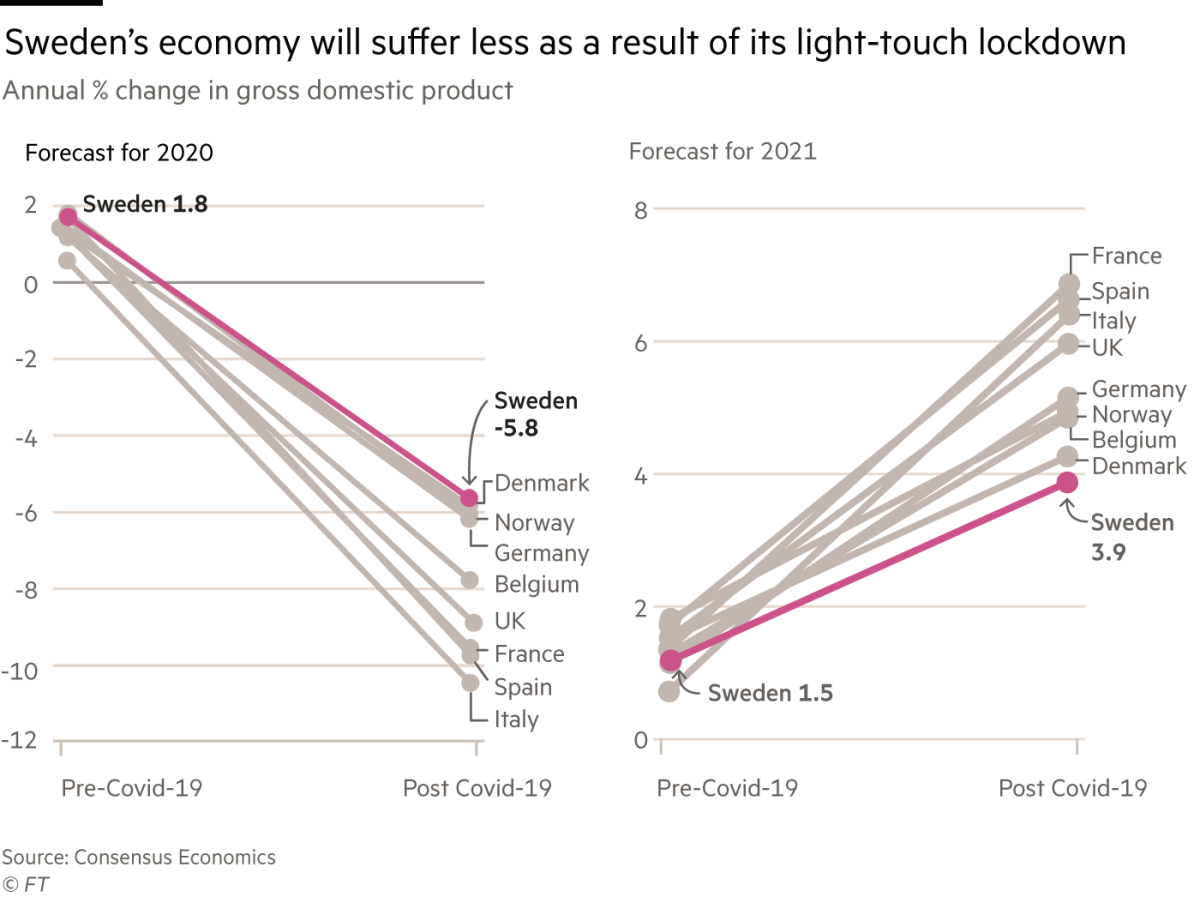Sweden starts to debate its coronavirus public health experiment

- Share via
GOTHENBURG, Sweden — The two sides of Sweden’s against-the-grain coronavirus strategy are visible from a small square in northeastern Gothenburg.
On one side lies the Gerashus care home, where more than a quarter of residents have died in the last three months, most of them from COVID-19. At the peak of the outbreak, two-thirds of its staff were absent.
On the other side of the square is a bustling tram stop where dozens of people wait to head into the center of Sweden’s second city and children come from a primary school. A steady stream of customers head into a convenience store to collect online shopping parcels or buy lottery tickets. Nobody wears a mask, but most keep a meter’s distance from each other.
“Life is the same really. There are people coming in all the time. You don’t think too much about corona. Everybody is going about their normal lives,” says 58-year-old Adrian, working in the store from behind a Plexiglas counter.
With Sweden the only EU country not to adopt a harsh lockdown, its light-touch coronavirus strategy has sparked enormous international attention — especially from rightwing populists who believe the virus has been overhyped.
Sweden has chosen to focus on public health in the broadest sense, aiming to keep as much of society open as possible, including restaurants, schools and fitness centers as well as its borders. The Scandinavian country of 10 million people has relied on voluntary recommendations for social distancing and working from home in its effort to flatten the curve enough to allow its healthcare system to keep functioning.
But a far higher death toll per capita than its Nordic neighbors has led Norway, Denmark and Finland — all of which locked down — to open their borders to each other but keep them closed to Sweden.
Swedes appear bewildered by the sudden scrutiny they are under. There is a widespread feeling that their decision to keep schools open for children up to the age of 16 was a wise one, but also that they have failed to protect their most vulnerable in care homes such as Gerashus.
Many Swedes were initially reassured that its response to the crisis had been led by healthcare experts, not politicians, fuelling a belief that it acted rationally as other countries responded emotionally. But the stubbornly high death toll — 102 new deaths were announced on Wednesday, more than Norway has had in the past two months cumulatively — has led to sharper domestic criticism of officials, including Anders Tegnell, the state epidemiologist who crafted Sweden’s approach.
The result is that everything is now up for discussion and the debate about whether Sweden’s approach has been right or wrong is just starting inside the country.
Leif Dotevall, communicable disease control officer in the region around Gothenburg, argues many people may be viewing Sweden’s strategy through the prism of whether they believe in lockdowns or not, rather than the overall health impact. “It makes the analysis right now skewed: you are so obsessed by your idea of the strategy and that emotional analysis makes you blind to the whole picture,” he adds.
But Elisabet Lann, the Gothenburg city council member responsible for elder care and a member of the opposition Christian Democrats who is skeptical about the government strategy, says 200 years of peace and neutrality have left Sweden slow to react. The response has been cloaked in a self-image of a country that believes it behaves calmly while others are impetuous.
“We don’t like to be irrational because of feelings, or be frightened to make irrational moves,” she says. “We look at other countries as more impulsive.”
‘We are open’
Situated on Sweden’s west coast, Gothenburg is home to some of the country’s biggest companies — from Volvo Cars and truckmaker Volvo AB to ball bearings manufacturer SKF and healthcare group Molnlycke. It is also home to some of the country’s most deprived areas such as Bergsjon, the northeastern suburb where Gerashus is situated and where unemployment before the coronavirus crisis was almost three times that of the city as a whole.
Vastra Gotaland, the region of 1.6 million people that includes Gothenburg, has had 649 COVID-19 deaths so far — more than the 598 in Denmark, 326 in Finland or 242 in Norway, all of which have more than triple the population. Sweden as a whole has suffered 5,053 deaths.
Henrik Tornqvist, a priest in Bergsjon, is one of those who has marked the change since March: he used to perform three or four funerals a month, now he does the same number each week. Up to 1,000 people a week used to attend homework groups, lunches and services at the church. “We are open but we don’t have a normal life,” he adds. He restarted services for the midsummer holiday on Sunday but with a congregation reduced from the usual 120 to 30.
Maria Ottensten, the head priest for northeastern Gothenburg, says of Sweden’s strategy: “We can keep going this way. It’s boring but we can keep it going. Closing everything down, you can’t do it for very long.”
Close by is one of the symbols of the Swedish strategy’s success: the primary school. Children up to 16 have gone to school throughout the crisis. Locals hail the policy for helping with children’s mental health as well as allowing parents to keep working. “I like playing with my friends, and not being inside all day,” says one teenager playing basketball outside the school.
In the centre of Gothenburg, a class of 9- and 10-year-olds from the French school has stopped in front of a statue of King Charles IX. Stefan, one of the teachers, says of the decision to keep schools open: “I think it’s been good. I’m not afraid of getting corona from them. If we close down the school, society will collapse because you need to have someone home.”
Gitte Caous is the director for the district of Eastern Gothenburg, which includes Bergsjon, and she emphasises that health is about more than purely preventing deaths. “A country doesn’t just consist of elderly people. It also consists of children, companies that could go bankrupt etc. Take suicides — people take their lives because they have been socially isolated,” she says.
Not all schools in Sweden have been open. It closed down those for over-16s as well as universities, judging that they could cope better with distance learning and reduce the pressure on public transport from older students who often have to travel further.
Camilla Alenas, head teacher at SKF’s Technical College which has 96 students, says the last three months have been challenging. “We have seen we need to work on mental health. The students haven’t said, ‘Oh, I need help’ like they used to,” she says, adding that the school has had to help some poorer pupils gain access to the internet. She is worried about those graduating: “It’s a bad time to go into the job market.”
‘This is a bit too normal’
Truckmaker Volvo underscored this by announcing more than 4,000 job cuts last week. The hit to Sweden’s economy from the coronavirus will be sizeable, raising the question over whether it is more influenced by the lack of a lockdown or by the spread of the virus. SEB, one of Sweden’s biggest banks, now forecasts gross domestic product will decline 5% this year, similar to its estimate for Norway and worse than Denmark’s latest guidance of a 4% contraction. Unemployment in Sweden could hit 12%, according to SEB, well above its financial crisis peak and almost double its pre-COVID rate. But Sweden’s economy is expected to do far better than the European countries most affected by coronavirus, such as the UK, France, Italy and Spain.
Hakan Samuelsson, chief executive of Volvo Cars based in western Gothenburg, says its Europe sales fell 50% in May but June is likely to be “much better.” He now expects a V-shaped recovery. “It will hurt the economy. But we can’t isolate this. We can’t close down our economy or our company and wait for a vaccine to come,” he says.
He adds that many talk about COVID-19 deaths but few discuss how many die each day from alcohol abuse or suicide. “A bad economy where people lose their income will cause social problems. Politicians need to recognise that closing down the economy will have negative effects,” he says.
The evidence from shops and cafés in Gothenburg that have stayed open throughout the pandemic is more mixed. A waiter at Cappuccino, a cafe in the city center, says: “It’s generally been quieter but now the days are warmer it’s the same. It’s back to usual — it’s kind of strange.” In the evening, bars nearby are packed and young men are drinking beer while playing golf. “I’m scared this is a bit too normal,” says one woman, trying to get her newborn baby to sleep in a pram.
In Bergsjon, where wages are lower and unemployment higher, shops are suffering more — a sign that a lack of a lockdown is not enough to keep the economy going when people are afraid of the virus. At Tintin’s hair salon, one of the hairdressers says business has more than halved. “We hope it comes back, but people are scared. There’s a lot of infection here. We are afraid soon it could be like Italy,” he says. The woman behind the counter at Horsed Beauty, a local clothes shop, adds: “It’s slow. There are not so many people because of corona.”

‘We have failed the elderly’
Like most countries with high per-capita death rates, Sweden has suffered a large number of deaths in care homes — in its case about half of total deaths. At Gerashus in Bergsjon, 28 of its 102 residents have died since March. The ward for dementia sufferers was particularly badly hit. One day, says Inger Bomark, head of elderly care in eastern Gothenburg, 66% of staff were off so temporary workers — often with few qualifications and bad language skills — were pressed into action, often working in several different wards or care homes.
“We have completely failed with old people,” says Anna Skarsjo, a care home nurse who is also head of the Kommunal trade union in western Sweden. She says the country has paid the price for decades of neglect, and that there were little to no plans on how to deal with COVID-19 in individual care homes and a lack of protective equipment. When she started working as a nurse 26 years ago, five staff would look after 10 residents; now there are three or four workers for 16 residents, she says.
“One can’t expect a three-course meal when you pay for a hot dog,” she adds.
The bigger question for Sweden is whether the problems in its care homes invalidate its entire strategy. Given that many countries have suffered about half their deaths in care homes, some in Sweden argue its elevated death rate is merely a function of the high infection level in society. Lann says: “I’m not sure if the strategy is right. If you choose a total lockdown it comes with a huge cost for schools, mental health. But a more common sense strategy requires more strict guidelines for elderly care. You can’t combine a common sense strategy with some kind of common sense in care homes.”
Dotevall argues that Sweden has a larger number of elderly people than other European countries and problems with its care homes for years, meaning the focus on the lack of a lockdown may be a red herring. “I’m not sure that the lockdown problem is the main thing, I think the problem lies more with the structure of care homes,” he says, adding that many Swedish care homes are too large and disconnected from the rest of the healthcare system while workers are often badly paid, poorly qualified and on hourly contracts.
“The situation for care home workers has to be improved. We have degraded the value of looking after old people,” he says. Ottensten, the priest, says it reflects the political choices of recent decades: “We have done nothing for care homes and lots for children.”
Another aspect of Sweden’s focus on broader public health rather than narrowly trying to reduce deaths from the coronavirus is that there is more talk about the invisible issues related to the pandemic such as mental health and domestic violence, even though the long-term impact — as for all countries — is impossible to discern yet.
Ing-Marie Larsson, head of social services in eastern Gothenburg, says: “The most vulnerable in our district, who have poor mental health, have had it very tough.” She adds that incidents of crime have decreased except those related to drugs.
Dotevall says domestic violence appears to have risen significantly despite no formal lockdown while many 16- to 19-year-olds with an immigrant background only ate warm meals in schools, which are now closed. “If you see society in the broader sense with restaurants and cafés and businesses, what happens in a total close-down? I don’t know. But when you analyze coronavirus, you have to see what has happened in all these areas — the economy, mental health and not just in the old people’s sector.”
In Gothenburg, as in Sweden as a whole, there is a sense that many of these questions could take years to decide. There are worries about the high death rate and the level of new coronavirus infections. Its excess deaths this year are proportionately higher than those of Norway and Denmark, which have similar population density and cultures, but less than the UK, Belgium or Italy. But for every Bergsjon with a high death and infection rate, there is another deprived area such as the neighboring district of Angered that has been far less affected by the coronavirus.
“All of us who work with this, every day and night, we think, ‘Was this right or wrong?’” said Dotevall. “Some days we think we were right and other days not at all. Finally, we may be surprised to see the whole picture.”
© The Financial Times Limited 2020. All Rights Reserved. FT and Financial Times are trademarks of the Financial Times Ltd. Not to be redistributed, copied or modified in anyway.
More to Read
Sign up for Essential California
The most important California stories and recommendations in your inbox every morning.
You may occasionally receive promotional content from the Los Angeles Times.










